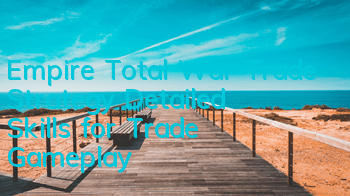Trade is an important gameplay in the game "Empire: Total War" and an important part of the game's development. So how to manage your own trade well? Today, the editor brings you a guide to the trade gameplay of "Empire: Total War". Let's take a look!
1. Trade points: Under the condition of monopolizing similar commodities, 5 boats (ivory 4) each point can achieve the maximum profit of commodity prices and commodity quantity. If half of them are not monopolized, the more they are better.
2. With the continent where the capital is located, the country and land border with the land and roads can be connected to land. There is no upper limit on the number of land trade countries, and the transaction volume far exceeds maritime trade. The profits of land trade have a lot to do with the road grade.
3. The capital's trading port determines the upper limit of the maritime trade line, and the trading ports of countries adjacent to the capital are also counted. For example, the trading ports in Scotland have the same functions as those in the capital, as well as Goa for Sister Ma, West Prussia for Prussia, Savoy for France, Portugal for Spain, etc.
The profits of maritime trade have a lot to do with the national port level, and the relationship with the other side's port level can be ignored.
4. Therefore, the UK is rich because the UK has the best port advantage in the world. As an aside, the requirement for Victory is the steam dry dock in the capital, but it is not limited to the dock at the beginning. Other ports in England can also produce the Victory dock.
5. The quantity of goods determines the difficulty of trade, and the surplus requires money from the other party. The deficit can be asked for money from the other party. For example, you can easily trade with Britain, France, Ma Jie and other countries at the beginning because they have colonial outputs that need to be dumped. But Türkiye, Sweden, and Austria may not be willing to pay attention to you, and they will probably have to pay.
6. The more trading countries, the more money it costs, because the more wealth it circulates in "other commodities". In fact, the ivory, spices, etc. produced in the colonies can eventually be sold and will not be accumulated in the country.
7. The longer the trade line exists, the higher the profit it generates. I don't believe it if it has anything to do with population. So don’t tear down the trade agreement casually. If you sign it again, the time bonus of the trade line must be calculated from a new beginning.
You can choose not to fight for poor small countries and trade with them with the highest cost-effectiveness.
Try to trade with countries that will not engage in war in the short term, so that the trade line can last as long as possible.
8. The price level of commodities depends on the total global population. So in the early stage, you can suppress spices to less than 10 yuan, and in the later stage, you can easily increase to 50 yuan.
9. During diplomatic negotiations, the amount of goods dumped determines how much you have to pay. I have poor Chinese, so I can give an example.
If I were Britain, I monopolized the commodities at the global trade point, with a total of 2,000 boxes of commodities, and there are 4 existing trading countries, each country receives 500 boxes of commodities per round. You can trade with 5 countriesYi, and when negotiating with the fifth country, the other party needs 10,000 gold coins to trade.
Then, you only need to pay 8,000 for the 6th country, and the 7th is 6,500 for the 7th,
Because the fifth country thinks that you want to sell him 500 boxes (2000÷4) each round, the fifth country thinks that you want to sell him 400 boxes (2000÷5), the sixth one thinks that you want to sell him 333 (2000÷6), the ninth one thinks that you want to sell him 250 boxes, you only need to pay 2,000 gold coins!
The above conclusions exist under the ideal situation of excluding the influence of diplomatic relations and the influence of the other party's colonies.
The above numbers are not very accurate, and the actual decreasing value is faster than this! Because even if there are no goods, you can still trade "other goods"! It is the empty box in the trade list, which is called other goods, and each country has "other goods".
So there are multiple trading objects, and choosing the order of transactions will affect the situation in the mainland, because the person who trades with you first gets more than several times the money that comes later.
If you don’t understand 6 and 7, please refer to this article, and you will be free to experiment if you don’t agree.
10. Domestic trade is the trade in colonies and trade points transporting goods back to the capital, trade in other places and capitals, trade in ports and regional capitals, which will not increase treasury income, but will increase regional wealth. This trade can be robbed by the army and the navy.
Summary:
About 6, 7, 9, I think many people find it difficult to understand, and it is also a misunderstanding among many people. Some people think it is related to the other party's population, some people think it is related to the other party's strength, and many people choose to trade countries with difficulty. To give the simplest example, when global rapid unification was later, trade with Mexico would have 5000 gold coins in one round, and 2000 gold coins were required to sign a trade agreement. How many people can Mexico have? What is its port level? There is no need to be a choice problem, your domestic output can be sold.
About 9, the final products can be sold, but the quantity sold is not absolutely average, and the proportion is different. For example, the sugar sold to the UK must be less than the sugar sold to Sweden, because the sugar produced in the UK!
About other commodities, they can be understood as commodities that come out of thin air, and they can also be understood as textile factories, wrought iron tools, steam engines, etc. produced in China. Therefore, you will feel that the profit is higher when trading with major countries such as Britain and France. When you open the trade interface, there are actually more other commodities.
About trade ships, the effects of all trade ships are the same. The difference is that the maintenance costs of Dutch merchant ships with Dutch specialties and Garen, the plate duck, are much higher; but the effect of East India merchant ships and Arab sloops in Eastern countries are the same, and the maintenance costs are the same, both are 50.









